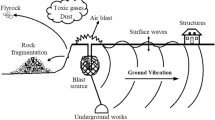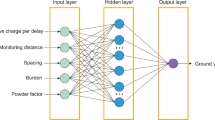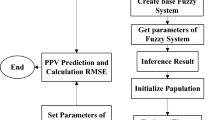Abstract
Prediction of ground vibration induced by blasting operations is a crucial challenge to engineers working in surface mines. This study aims to assess the efficiency of two advanced machine learning models in predicting ground vibrations in a granite quarry located in Malaysia. To this end, two intelligent models were proposed by hybridizing the relevance vector regression (RVR) with the grey wolf optimization (GWO) (which formed the RVR-GWO model) and with the bat-inspired algorithm (BA) (which formed the RVR-BA model). To the best of our knowledge, this is the first attempt to predict ground vibration using the RVR-GWO and RVR-BA models. The afore-mentioned models were developed and tested using 95 datasets. Then, the performance of the developed models was statistically checked through four comparative experiments using, among others, mean square error (MSE) and correlation coefficient (R). The results indicated the superiority of the RVR-GWO model over the RVR-BA model in terms of prediction precision. The RVR-GWO model with R of 0.915 and MSE = 7.920 predicted the ground vibration better than the RVR-BA model with R of 0.867 and MSE = 8.551. Accordingly, it was concluded that applying the GWO algorithm to RVR can result in high accuracy in the prediction of blast-induced ground vibration.









Similar content being viewed by others
References
Abbas, A. S., & Asheghi, R. (2018). Optimized developed artificial neural network-based models to predict the blast-induced ground vibration. Innovative Infrastructure Solutions, 3, 1–10.
Amiri, M., Hasanipanah, M., & Bakhshandeh Amnieh, H. (2020). Predicting ground vibration induced by rock blasting using a novel hybrid of neural network and itemset mining. Neural Computing and Applications. https://doi.org/10.1007/s00521-020-04822-w.
Ansari, H. R., & Gholami, A. (2015). An improved support vector regression model for estimation of saturation pressure of crude oils. Fluid Phase Equilibr, 402, 124–132.
Bui, X., Choi, Y., Atrushkevich, V., Nguyen, H., Tran, Q. H., Long, N. Q., et al. (2020). Prediction of blast-induced ground vibration intensity in open-pit mines using unmanned aerial vehicle and a novel intelligence system. Natural Resources Research, 29, 771–790.
Chen, W., Hasanipanah, M., Rad, H. N., Armaghani, D. J., & Tahir, M. M. (2019). A new design of evolutionary hybrid optimization of SVR model in predicting the blast-induced ground vibration. Engineering with Computers. https://doi.org/10.1007/s00366-019-00895-x.
Ding, Z., Nguyen, H., Bui, X. N., Zhou, J., & Moayedi, H. (2020). Computational intelligence model for estimating intensity of blast-induced ground vibration in a mine based on imperialist competitive and extreme gradient boosting algorithms. Natural Resources Research, 29(2), 751–769.
Fang, Y., & Su, Y. (2020). On the use of the global sensitivity analysis in the reliability-based design: Insights from a tunnel support case. Computers and Geotechnics, 117, 103280.
Fang, Q., Zhang, D., Li, Q., & Wong, L. N. Y. (2015). Effects of twin tunnels construction beneath existing shield-driven twin tunnels. Tunnelling and Underground Space Technology, 45, 128–137.
Fang, Y., Su, Y., Su, Y., & Li, S. (2019). A direct reliability-based design method for tunnel support using the performance measure approach with line search. Computers and Geotechnics, 107, 89–96.
Fang, Q., Nguyen, H., Bui, X. N., & Nguyen-Thoi, T. (2020a). Prediction of blast-induced ground vibration in open-pit mines using a new technique based on imperialist competitive algorithm and M5Rules. Natural Resources Research, 29(2), 791–806.
Fang, Q., Nguyen, H., Bui, X., & Tran, Q. H. (2020b). Estimation of blast-induced air overpressure in quarry mines using cubist-based genetic algorithm. Natural Resources Research, 29, 593–607.
Fattahi, H. (2015a). Indirect estimation of deformation modulus of an in situ rock mass: An ANFIS model based on grid partitioning, fuzzy c-means clustering and subtractive clustering. Geosciences Journal, 20(5), 681–690.
Fattahi, H. (2015b). Prediction of slope stability state for circular failure: A hybrid support vector machine with harmony search algorithm. International Journal of Optimization in Civil Engineering, 5(1), 103–115.
Fattahi, H. (2020a). Analysis of rock mass boreability in mechanical tunneling using relevance vector regression optimized by dolphin echolocation algorithm. International Journal of Optimization in Civil Engineering, 10(3), 481–492.
Fattahi, H. (2020b). A new method for forecasting of uniaxial compressive strength of weak rocks. Journal of Mining and Environment, 11(2), 505–515.
Fattahi, H. (2020c). Tunnel boring machine penetration rate prediction based on relevance vector regression. International Journal of Optimization in Civil Engineering, 9(2), 343–353.
Gao, J., Nait Amar, M., Motahari, M. R., Hasanipanah, M., & Jahed Armaghani, D. (2020). Two novel combined systems for predicting the peak shear strength using RBFNN and meta-heuristic computing paradigms. Engineering with Computers. https://doi.org/10.1007/s00366-020-01059-y.
Geem, Z. W., Kim, J. H., & Loganathan, G. V. (2001). A new heuristic optimization algorithm: Harmony search. Simulation, 76(2), 60–68.
Ghasemi, E., Ataei, M., & Hashemolhosseini, H. (2013). Development of a fuzzy model for predicting ground vibration caused by rock blasting in surface mining. Journal of Vibration and Control, 19(5), 755–770.
Ghosh, A., & Daemen, J. J. (1983) A simple new blast vibration predictor (based on wave propagation laws). In The 24th US symposium on rock mechanics (USRMS). American Rock Mechanics Association.
Hajihassani, M., Jahed Armaghani, D., Marto, A., & Tonnizam Mohamad, E. (2014). Ground vibration prediction in quarry blasting through an artificial neural network optimized by imperialist competitive algorithm. Bulletin of Engineering Geology and the Environment, 74, 873–886.
Hajihassani, M., Armaghani, D. J., Monjezi, M., Mohamad, E. T., & Marto, A. (2015). Blast-induced air and ground vibration prediction: A particle swarm optimization-based artificial neural network approach. Environmental Earth Sciences, 74(4), 2799–2817.
Hasanipanah, M., & Amnieh, H. B. (2020a). A fuzzy rule-based approach to address uncertainty in risk assessment and prediction of blast induced Flyrock in a quarry. Natural Resources Research, 29(2), 669–689.
Hasanipanah, M., & Amnieh, H. B. (2020b). Developing a new uncertain rule-based fuzzy approach for evaluating the blast-induced backbreak. Engineering with Computers. https://doi.org/10.1007/s00366-019-00919-6.
Hasanipanah, M., Faradonbeh, R. S., Amnieh, H. B., Armaghani, D. J., & Monjezi, M. (2017). Forecasting blast-induced ground vibration developing a CART model. Engineering with Computers, 33(2), 307–316.
Hasanipanah, M., Armaghani, D. J., Amnieh, H. B., Koopialipoor, M., & Arab, H. (2018a). A risk-based technique to analyze flyrock results through rock engineering system. Geotechnical and Geological Engineering, 36(4), 2247–2260.
Hasanipanah, M., Bakhshandeh Amnieh, H., Arab, H., & Zamzam, M. S. (2018b). Feasibility of PSO–ANFIS model to estimate rock fragmentation produced by mine blasting. Neural Computing and Applications, 30(4), 1015–1024.
Hasanipanah, M., Keshtegar, B., Thai, D., & Trung, N. T. (2020a). An ANN-adaptive dynamical harmony search algorithm to approximate the flyrock resulting from blasting. Engineering with Computers. https://doi.org/10.1007/s00366-020-01105-9.
Hasanipanah, M., Meng, D., Keshtegar, B., Trung, N. T., & Thai, D. K. (2020b). Nonlinear models based on enhanced Kriging interpolation for prediction of rock joint shear strength. Neural Comput & Applic. https://doi.org/10.1007/s00521-020-05252-4.
Jahed Armaghani, D., Kumar, D., Samui, P., Hasanipanah, M., & Roy, B. (2020). A novel approach for forecasting of ground vibrations resulting from blasting: Modified particle swarm optimization coupled extreme learning machine. Engineering with Computers. https://doi.org/10.1007/s00366-020-00997-x.
Jiang, W., Arslan, C. A., Tehrani, M. S., Khorami, M., & Hasanipanah, M. (2019). Simulating the peak particle velocity in rock blasting projects using a neuro-fuzzy inference system. Engineering with Computers, 35(4), 1203–1211.
Jing, H., Rad, H. N., Hasanipanah, M., Armaghani, D. J., & Qasem, S. N. (2020). Design and implementation of a new tuned hybrid intelligent model to predict the uniaxial compressive strength of the rock using SFS-ANFIS. Engineering Computations. https://doi.org/10.1007/s00366-020-00977-1.
Khandelwal, M., Kumar, D. L., & Yellishetty, M. (2011). Application of soft computing to predict blast-induced ground vibration. Engineering with Computers, 27(2), 117–125.
Li, G., Kumar, D., Samui, P., Nikafshan Rad, H., Roy, B., & Hasanipanah, M. (2020). Developing a new computational intelligence approach for approximating the blast-induced ground vibration. Applied Sciences, 10(2), 434.
Matidza, M. I., Jianhua, Z., Gang, H., Gang, H., & Mwangi, A. D. (2020). Assessment of blast-induced ground vibration at Jinduicheng Molybdenum open pit mine. Natural Resources Research, 29, 831–841.
Mehrdanesh, A., Monjezi, M., & Sayadi, A. R. (2019). Evaluation of effect of rock mass properties on fragmentation using robust techniques. Engineering with Computers, 34(2), 253–260.
Mirjalili, S., Mirjalili, S. M., & Lewis, A. (2014). Grey wolf optimizer. Advanced Engineering Software, 69, 46–61.
Mirjalili, S., Saremi, S., Mirjalili, S. M., & Coelho, L. D. S. (2016). Multi-objective grey wolf optimizer: A novel algorithm for multi-criterion optimization. Expert Systems with Applications, 47, 106–119.
Monjezi, M., Rezaei, M., & Yazdian Varjani, A. (2009). Prediction of rock fragmentation due to blasting in Gol-E-Gohar iron mine using fuzzy logic. International Journal of Rock Mechanics and Mining Sciences, 46, 1273–1280.
Monjezi, M., Ahmadi, M., Sheikhan, M., Bahrami, A., & Salimi, A. (2010). Predicting blast-induced ground vibration using various types of neural networks. Soil Dynamics and Earthquake Engineering, 30(11), 1233–1236.
Monjezi, M., Ghafurikalajahi, M., & Bahrami, A. (2011). Prediction of blast-induced ground vibration using artificial neural networks. Tunnelling and Underground Space Technology, 26(1), 46–50.
Monjezi, M., Hasanipanah, M., & Khandelwal, M. (2013). Evaluation and prediction of blast-induced ground vibration at Shur River Dam, Iran, by artificial neural network. Neural Computing and Applications, 22(7–8), 1637–1643.
Mostafaeipour, A., Goli, A., & Qolipour, M. (2018). Prediction of air travel demand using a hybrid artificial neural network (ANN) with Bat and Firefly algorithms: a case study. J Supercomput, 74, 5461–5484.
Nikafshan Rad, H., Hasanipanah, M., Rezaei, M., & Eghlim, A. L. (2018). Developing a least squares support vector machine for estimating the blast-induced flyrock. Engineering with Computers, 34(4), 709–717.
Ramezanalizadeh, T., Monjezi, M., Sayadi, A. R., & Mousavi, A. (2020a). Development of a MIP model to maximize NPV and minimize adverse environmental impact—a heuristic approach. Environmental Monitoring and Assessment, 192(9), 1–15.
Ramezanalizadeh, T., Monjezi, M., Sayadi, A. R., & Mousavinogholi, A. (2020b). Development of an integrated mathematical model to optimize waste rock dumping satisfying environmental aspects. Journal of Mining and Environment, 11(2), 577–586.
Rezaei, M., Monjezi, M., & Varjani, A. Y. (2011). Development of a fuzzy model to predict flyrock in surface mining. Safety Science, 49(2), 298–305.
Roy, P. P. (1991). Vibration control in an opencast mine based on improved blast vibration predictors. Mining Science and Technology, 12(2), 157–165.
Saadat, M., Khandelwal, M., & Monjezi, M. (2014). An ANN-based approach to predict blast-induced ground vibration of Gol-E-Gohar iron ore mine. Iran. Journal of Rock Mechanics and Geotechnical Engineering, 6(1), 67–76.
Saba, S., Ahsan, F., & Mohsin, S. (2017). BAT-ANN based earthquake prediction for Pakistan region. Soft Computing, 21, 5805–5813.
Shang, Y., Nguyen, H., Bui, X., Tran, Q. H., & Moayedi, S. (2020). A novel artificial intelligence approach to predict blast-induced ground vibration in open-pit mines based on the firefly algorithm and artificial neural network. Natural Resources Research, 29, 723–737.
Shariati, M., Mafipour, M. S., Ghahremani, B., Azarhomayun, F., Ahmadi, M., Trung, N. T., et al. (2020). A novel hybrid extreme learning machine–grey wolf optimizer (ELM-GWO) model to predict compressive strength of concrete with partial replacements for cement. Engineering with Computers. https://doi.org/10.1007/s00366-020-01081-0.
Tipping, M. E. (2001). Sparse Bayesian learning and the relevance vector machine. Jounal of Machine Learning Research, 1, 211–244.
Xu, C., Nait Amar, M., Ghriga, M. A., Ouaer, H., Zhang, X., & Hasanipanah, M. (2020). Evolving support vector regression using Grey Wolf optimization; forecasting the geomechanical properties of rock. Engineering with Computers. https://doi.org/10.1007/s00366-020-01131-7.
Yang, X. S. (2010). A new metaheuristic bat-inspired algorithm. In J. R. González, D. A. Pelta, C. Cruz, G. Terrazas, & N. Krasnogor (Eds.), Nature inspired cooperative strategies for optimization (NICSO 2010) (pp. 65–74). Berlin: Springer.
Yang, H., Hasanipanah, M., Tahir, M. M., & Bui, D. T. (2020a). Intelligent prediction of blasting-induced ground vibration using ANFIS optimized by GA and PSO. Natural Resources Research, 29, 739–750.
Yang, H., Nikafshan Rad, H., Hasanipanah, M., Bakhshandeh Amnieh, H., & Nekouie, A. (2020b). Prediction of vibration velocity generated in mine blasting using support vector regression improved by optimization algorithms. Natural Resources Research, 29, 807–830.
Yu, Z., Shi, X., Qiu, X., Zhou, J., Chen, X., & Gou, Y. (2020a). Optimization of postblast ore boundary determination using a novel sine cosine algorithm-based random forest technique and Monte Carlo simulation. Engineering Optimization. https://doi.org/10.1080/0305215X.2020.1801668.
Yu, Z., Shi, X., Zhou, J., Chen, X., Miao, X., Teng, B., et al. (2020b). Prediction of blast-induced rock movement during bench blasting: Use of gray wolf optimizer and support Vector regression. Natural Resources Research, 29, 843–865.
Yu, Z., Shi, X., Zhou, J., Gou, Y., Huo, X., Zhang, J., et al. (2020c). A new multikernel relevance vector machine based on the HPSOGWO algorithm for predicting and controlling blast-induced ground vibration. Engineering with Computers. https://doi.org/10.1007/s00366-020-01136-2.
Zhang, X., Nguyen, H., Bui, X. N., Tran, Q. H., Nguyen, D. A., Tien Bui, D., et al. (2019). Novel soft computing model for predicting blast-induced ground vibration in open-pit mines based on particle swarm optimization and XGBoost. Natural Resources Research, 29, 711–721.
Zhou, J., Li, X., & Mitri, H. S. (2015). Comparative performance of six supervised learning methods for the development of models of hard rock pillar stability prediction. Natural Hazards, 79(1), 291–316.
Zhou, J., Aghili, N., Noroozi Ghaleini, E., Tien Bui, D., Tahir, M. M., & Koopialipoor, M. (2019a). A Monte Carlo simulation approach for effective assessment of flyrock based on intelligent system of neural network. Engineering with Computers. https://doi.org/10.1007/s00366-019-00726-z.
Zhou, J., Li, E., Yang, S., Wang, M., Shi, X., Yao, S., et al. (2019b). Slope stability prediction for circular mode failure using gradient boosting machine approach based on an updated database of case histories. Safety Science, 118, 505–518.
Zhou, J., Nekouie, A., Arslan, C. A., Pham, B. T., & Hasanipanah, M. (2019c). Novel approach for forecasting the blast induced AOp using a hybrid fuzzy system and firefly algorithm. Engineering with Computers. https://doi.org/10.1007/s00366-019-00725-0.
Zhou, J., Chen, C., Du, K., Armaghani, D. J., & Li, C. (2020). A new hybrid model of information entropy and unascertained measurement with different membership functions for evaluating destressability in burst-prone underground mines. Engineering with Computers. https://doi.org/10.1007/s00366-020-01151-3.
Acknowledgments
The authors would like to thank Dr. Jahed Armaghani for providing the information and facilities required for conducting this research.
Author information
Authors and Affiliations
Corresponding author
Rights and permissions
About this article
Cite this article
Fattahi, H., Hasanipanah, M. Prediction of Blast-Induced Ground Vibration in a Mine Using Relevance Vector Regression Optimized by Metaheuristic Algorithms. Nat Resour Res 30, 1849–1863 (2021). https://doi.org/10.1007/s11053-020-09764-7
Received:
Accepted:
Published:
Issue Date:
DOI: https://doi.org/10.1007/s11053-020-09764-7




